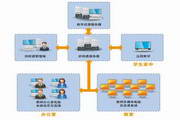Keyuda Banbantong software is a software professionally used for the management, statistics and application of Banbantong (teaching platform) by education bureaus or schools. The software integrates unified management of equipment, audio and video live broadcast, teaching resource management, A multimedia management platform integrating interactive information exchange, auxiliary classroom teaching and distance teaching.
1. Centralized and unified management
Administrators can monitor the screen remotely and check the operation status of each class's equipment in real time to ensure the normal operation of each class's equipment. It supports real-name display of the teacher's name and class name to effectively understand the teacher's class status. It can also remotely restart and Shut down, send messages, transfer files, etc. to help administrators remotely manage dispersed devices in a standardized and unified manner, thereby saving resources and extending service life.
2. Usage time statistics: Statistics can be made from both the equipment and user aspects. The frequency of teachers using Banbantong equipment and the comprehensive utilization rate of Banbantong equipment can be queried by time period. This can urge teachers to use Banbantong equipment to carry out teaching, and also Provide real data support for supervisors’ decision-making.
3. Log system
Detailed logs of the use of Banbantong equipment and teachers can be automatically collected, and the specific use of Banbantong equipment by a user within a certain period of time can be queried at any time. It can effectively supervise teachers' teaching and promote the orderly development of efficient classrooms.
4. Behavior authority management
In order to better create a green classroom, ensure information security, and avoid behaviors unrelated to teaching. It supports customized behavior permission settings based on time periods. It can lock the screen, disable bad programs, ban URLs, IP bans, text filtering, ban the use of USB flash drives, etc. to effectively manage Banbantong devices. It can adjust the allocation of network resources and avoid students Stealing classroom computers can help standardize the use of class communication and ensure the safety of the equipment.
5. Resource management platform
Supporting the construction of a local teaching resource library, school teachers can be organized to co-build and share the resource platform, and different permissions can be assigned to teachers of different subjects and grades, which is conducive to the classified management of resources. Supports automatic statistics of resource usage by time period, making it easier for schools to commend teachers who have made outstanding contributions and stimulate teachers' enthusiasm to jointly build a resource library.
6. Video/screen broadcast
It supports cross-campus remote screen broadcasts and simultaneous audio and video live broadcasts. It can hold some large-scale lectures, parent meetings, video conferences to release some major news, notices or play educational films, etc. Teachers and students can receive relevant information without leaving the classroom.
7. Information exchange
This function is mainly used for activities such as topic discussions, school-based teaching and research, teaching and research group meetings, etc. Teachers can have audio and video conversations (one-to-one support), and display and send files in real time with text, pictures, voice, video, etc. Expand activities.
8. Network hard drive
Allocate collective shared network disks and personal network disks to teachers. Teachers can directly store some lesson preparation materials on the network hard drive in different places such as classrooms, offices, homes, etc., and call them directly during class without carrying a USB flash drive to avoid viruses. Distributed via USB flash drive.
9. Online courses
It can be used to carry out teaching activities between teachers in high-quality courses and open classes. The lead teacher creates a class in the lecture mode, and other teachers enter the class in the audit mode. It also supports real-time interactive communication such as drawing board collaboration and voice between the audit teachers and the lead teacher.
10. Real-name login management
Teachers can use their own usernames and passwords to log in and use the ClassTong device. The software can record in detail the time, location and content of each teacher's use of the ClassTong device, and automatically calculate various data needed for ClassTong management and assessment to ensure that the The data is objective, accurate and fair.
11. Distance teaching
This function is mainly aimed at teaching plans when major natural disasters and epidemic diseases occur. It supports two-way or multi-way remote audio and video. Teachers can use the shared window to browse the web and demonstrate teaching materials such as PPT, WORD documents, and streaming media files. Teachers can communicate with Students can collaborate on sketchpads, arrange homework, automatically record teaching, and play videos on demand; it has rich and diverse interactive links such as multiple-choice questions in class, raising hands to answer questions, etc.




 360 Guardian
360 Guardian
 360 software manager
360 software manager
 driver wizard
driver wizard
 Baidu Skydisk
Baidu Skydisk
 360 browser
360 browser
 WPS Office
WPS Office
 QQ game hall
QQ game hall
 Lightning simulator
Lightning simulator
it works
it works
it works